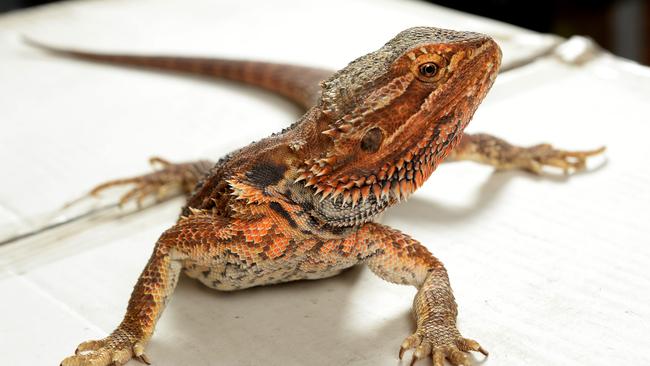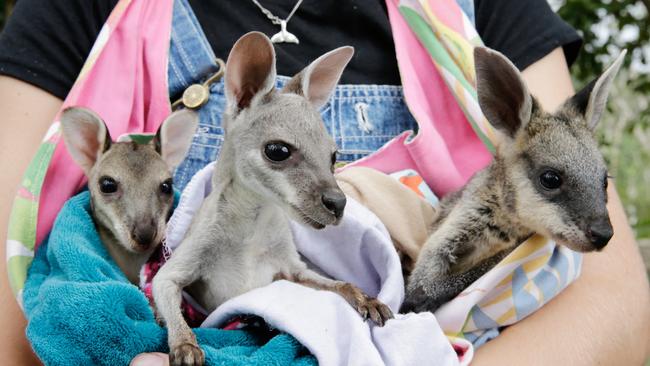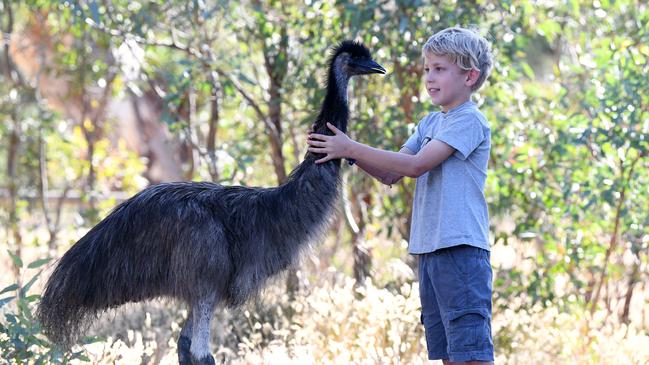Me and my emu: The native animals you can legally keep as pets in SA, and the permits you need
Nine-year-old Felix has a rather unusual pet. But it turns out that keeping native birds, reptiles and mammals as pets isn’t as rare as you may suspect.
Pets and Wildlife
Don't miss out on the headlines from Pets and Wildlife. Followed categories will be added to My News.
South Australians are keeping thousands of native animals, birds and reptiles as pets, latest permit data shows, and likely thousands more that go uncounted because keeping them no longer requires official approval.
The Environment and Water Department has issued more than 30,000 current wildlife permits for animals held in captivity, including pets in South Australian households as well as specialised facilities such as zoos and sanctuaries.
But changes in the keeping schedules under wildlife regulations, introduced on July 1, 2019, meant some animals became “exempt” from the permit system, as conservation and wildlife director Lisien Loan explains.
“Exempt species, whilst protected in the wild, do not require a permit to keep or breed in captivity,” she said.
“Therefore we have no way of knowing who keeps, sells or breeds exempt species, as there is no legal requirement for them to obtain a permit nor report on these animals.”
There were many category changes in 2019, with some species becoming easier to obtain and other moving out of reach, becoming specialist animals requiring the highest level of expertise and facilities.
Popular pets with the highest number of permits issued include reptiles such as the carpet python, central bearded dragon and water dragon, birds such as the diamond firetail, eastern rosella, Australian king-parrot and Major Mitchell’s cockatoo. But there are mammals too, such as the Tammar wallaby, sugar glider and Rufous bettong.
At South Australia’s largest reptile shop, Reptile City, bearded dragon sales increased when the changes were introduced, removing the need for a permit, owner Blake Peboeck said.
“Beardies are now exempt (from needing a wildlife permit). Years ago, I would guarantee you, they would be number one (for the highest number of permits issued), we probably sell 400 to 500 beardies a year,” he said
“Snake-wise, we normally do about 300, a year, in total, for all the different species, but in beardies, just in one species, it’s over that number already.”

Mr Peboeck said also welcomed the introduction of a cheap ($20.40) “sell permit” for single animals in the basic category. That means people with just one animal in the basic category can legally sell or give away their pet without having to fork out $70 for the full basic permit. (You do not need a permit to keep just one basic animal. However, you need a permit to sell or give away one basic animal).
“It‘s a massive difference, so a lot more people seem to be trying to do the right thing there,” he said.
But he’s critical of the fact that pet shops with no licence at all can sell reptiles in the exempt category such as the central bearded dragon, blue-tongue and sleepy lizard.
“We think you should have to have a commercial licence to sell reptiles, whether they need a permit or not,” he said.
“So there is a few loopholes of the system still, but I think that’s the same with anything and everything at the end day.”

Fauna Rescue of SA chairwoman Marie Kozulic said keeping wildlife as pets was a big commitment. Rescue volunteers sometimes have to care for animals that have been released back into the wild but are too tame to survive on their own. She specialises in birds and has seen magpies and rosellas in particular, taken in as babies and then “set free” later in life.
“And what they do is they just run up to the first person looking for food, they’ve become too humanised,” she said.
“So at Fauna rescue what we do is we creche the birds, which means we put a group together, which stops them from bonding to the human. That means that they have a better opportunity to survive once they’re in the wild.”
MEET KIRI THE PET EMU

Pet emu Kiri is right at home with her Birdwood family, she loves a cuddle in the afternoon and even joins in for team sports.
Mother of four Melissa Rosenberg said her second-eldest son Felix, 9 had always wanted an emu, “ever since he could walk and talk”.
“We thought it was a bit of a joke to be honest, in the beginning, you know, you can’t have an emu as a pet,” she said.
“And then, I joined a Facebook emu page and I kept seeing all these people that had emus as pets and they just looked so fun and goofy and, you know, so silly.”
Then last year, after COVID changed everything, Mrs Rosenberg saw an opportunity to welcome an emu chick into the family.
“So we just bit the bullet and thought if it goes wrong, we’ll deal with it later.
“She was five days old when we got her and she was just the cutest thing you’ve ever seen.”
That was August, so Kiri has changed a lot since then. She’s taller than Felix and still has a bit more growing to do before she reaches maturity.
But she’s grown out of sleeping indoors, she has a safe area in the yard instead.

“I’d have to say that honestly, she’s the best thing that we have done in the last year, because all of our kids were so stressed, because of the COVID and the lockdown and the homeschooling,” Mrs Rosenberg said.
“But once that emu turned up, I think the kids completely forgot about it. Because they had Kiri, they played with her all the time, and when they were going to school (again) and they came back she was there, you know, we call her a therapy emu, she just made everybody happier, all of us.”
And that extends to family friends who have become Kiri fans on Facebook, looking out for the updates, photos and videos.
“When she runs her body goes one way and her legs kind of go the other, when she goes off,” Mrs Rosenberg said.
“I wanted to put it to Benny Hill music. Because it is so silly. Like she literally jumps and dances and she wriggles her whole body around, it just cracks you up, she’s great fun.”




